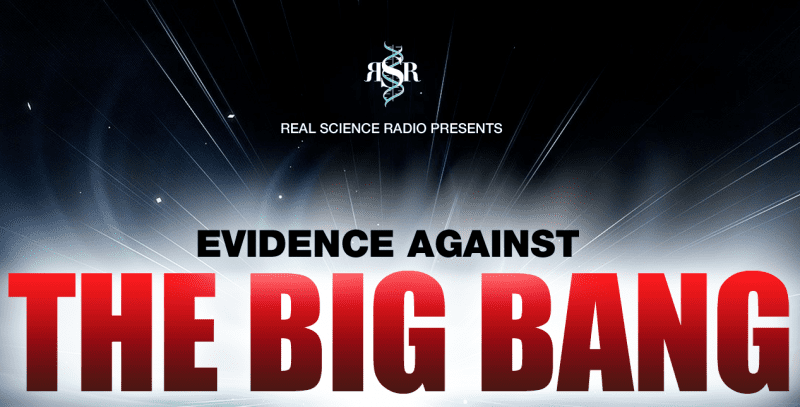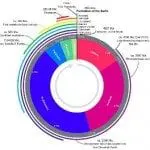
During Real Science Radio’s interview with Dr. Lawrence Krauss, a leading big bang proponent, he told us that, “all evidence overwhelmingly supports the big bang.” Wow. So we assembled the following list of (mostly peer-reviewed) scientific evidence which overtly challenges the big bang and the widely-held major features of its cosmological belief system. Krauss, a theoretical physicist (emphasis on the theoretical), has yet to explain how such major scientific discoveries as those on this list could possibly support the big bang…
Summary of RSR’s List of Evidence Against the Big Bang: For descriptions and links to journal references, see below.
– Mature galaxies exist where the Big Bang predicts only infant galaxies (like the 13.2Bly-away EGS8p7)
– An entire universe-worth of missing antimatter contradicts the most fundamental BB prediction
– Observations show that spiral galaxies are the missing millions of years of BB-model predicted collisions
– Clusters of galaxies exist at great distances where the big bang model predicts they should not exist
– A trillion stars are missing an unimaginably massive quantity of heavy elements, a total of nine billion years worth
– Galaxy superclusters exist yet the BB predicts that gravity couldn’t form them even in the alleged age of the cosmos
– A missing generation of the alleged billions of first stars that the failed search has implied simply never existed
– Missing uniform distribution of earth’s radioactivity
– Overall big bang cosmological system model failing at solar system formation level also
– It is “philosophy”, not science, that makes the big-bang claim that the universe has no center
– Amassing evidence suggests the universe may have a center
– Sun is missing nearly 100% of the spin that natural formation would impart
– The beloved supernova chemical evolution story for the formation of heavy elements is now widely rejected
– Missing uniform distribution of solar system isotopes
– Missing billions of years of additional clustering of nearby galaxies
– Surface brightness of the furthest galaxies, against a fundamental BB claim, is identical to that of the nearest galaxies
– Missing the long-predicted “quieter” echo (big bang shadow) behind nearby galaxy clusters now disproved
– The big bang “predictions” like CMB, etc., failing to confirm theory: Google: big bang predictions; see RSR at about #1
– These “shouldn’t exist” – a supermassive black hole, an iron-poor star, and a dusty galaxy – but they do
– Fine tuning and dozens of other MAJOR scientific observations and 1,000+ scientists doubting the big bang.
RSR’s List of Evidence Against the Big Bang
 Mature galaxies exist where the BB predicts only infant galaxies: The big bang predicts that when telescopes peer especially far into outer space, they should see only infant galaxies. Why? Because if the universe is 13.8 billion years old, light traveling toward us for 13.2 billion years would show objects as they had existed in the early stage of the universe, long before the BB theory has claimed that mature and bright galaxies could posibly exist. Instead though, as RSR host Bob Enyart has been reporting for two decades, astronomers are repeatedly “startled” and “baffled” (per the journal Science) to observe that what actually exists is exactly what the big bang predicts should not exist. For many of the most distant (i.e., allegedly “youngest”) galaxies look just like the Milky Way and the oldest galaxies that are all around us! Just in time for our 2014 RSR big bang program, the Carnegie Observatories: “discovered 15 [more] massive, mature galaxies located where they shouldn’t be: at an average distance of 12 billion light years away from Earth.” And in 2015, Caltech astronomers discovered Galaxy EGS8p7 at an astoundingly high redshift of 8.68 putting it apparently 13.2Bly away! (And then the Astrophysical Journal reports this: z=11!) Such discoveries prove wrong Neil deGrasse Tyson and his claim last week that we creationists cannot not make predictions, as any glance at our RSR Predictions and our confirmed predictions shows. In 2005 a cover story Science News stated, “Imagine peering into a nursery and seeing, among the cooing babies, a few that look like grown men. That’s the startling situation that astronomers have stumbled upon as they’ve looked deep into space and thus back to a time when newborn galaxies filled the cosmos. Some of these babies have turned out to be nearly as massive as the Milky Way and other galactic geezers that have taken billions of years to form.” Finally, in 1995, as NASA was preparing to publish their first Hubble Deep Field Image, as a biblical creationist, Bob Enyart predicted that NASA and the entire big bang community of astronomers, physicists and astrophysicists, would all be wrong, because the furthest galaxies would look just like nearby galaxies regarding apparent age. Learn more including here, here, here from the journal Science, and here from the journal Nature with their A galaxy far, far away!
Mature galaxies exist where the BB predicts only infant galaxies: The big bang predicts that when telescopes peer especially far into outer space, they should see only infant galaxies. Why? Because if the universe is 13.8 billion years old, light traveling toward us for 13.2 billion years would show objects as they had existed in the early stage of the universe, long before the BB theory has claimed that mature and bright galaxies could posibly exist. Instead though, as RSR host Bob Enyart has been reporting for two decades, astronomers are repeatedly “startled” and “baffled” (per the journal Science) to observe that what actually exists is exactly what the big bang predicts should not exist. For many of the most distant (i.e., allegedly “youngest”) galaxies look just like the Milky Way and the oldest galaxies that are all around us! Just in time for our 2014 RSR big bang program, the Carnegie Observatories: “discovered 15 [more] massive, mature galaxies located where they shouldn’t be: at an average distance of 12 billion light years away from Earth.” And in 2015, Caltech astronomers discovered Galaxy EGS8p7 at an astoundingly high redshift of 8.68 putting it apparently 13.2Bly away! (And then the Astrophysical Journal reports this: z=11!) Such discoveries prove wrong Neil deGrasse Tyson and his claim last week that we creationists cannot not make predictions, as any glance at our RSR Predictions and our confirmed predictions shows. In 2005 a cover story Science News stated, “Imagine peering into a nursery and seeing, among the cooing babies, a few that look like grown men. That’s the startling situation that astronomers have stumbled upon as they’ve looked deep into space and thus back to a time when newborn galaxies filled the cosmos. Some of these babies have turned out to be nearly as massive as the Milky Way and other galactic geezers that have taken billions of years to form.” Finally, in 1995, as NASA was preparing to publish their first Hubble Deep Field Image, as a biblical creationist, Bob Enyart predicted that NASA and the entire big bang community of astronomers, physicists and astrophysicists, would all be wrong, because the furthest galaxies would look just like nearby galaxies regarding apparent age. Learn more including here, here, here from the journal Science, and here from the journal Nature with their A galaxy far, far away!
An entire universe worth of missing antimatter: When supercolliders form matter from energy, as expected from the laws of physics, equal parts of matter and antimatter form, which is exactly what should have happened if an energetic big bang created all the matter of the universe. So astrophysicists have spent decades looking for antimatter regions of the universe with scientists culminating a significant project by writing in The Astrophysical Journal, “we conclude that a matter-antimatter symmetric universe is empirically excluded” with the journal Science reporting a physicist’s assessment: “The work is extremely compelling and gives me fresh pessimism” that is, on the difficulty of explaining why the matter of the universe even exists by way of a big bang. Consider also 1) Lawrence Krauss waving away this universe-worth of evidence on a Discovery Channel program; and 2) biology’s right- and left-handed parallel to cosmology’s antimatter problem; and 3) see RSR.org/big-bang-predictions (or its summary below) which disproves the claim that predictions have confirmed the big bang.
Spiral galaxies missing millions of years of collisions: A major big bang prediction was falsified so strongly that Princeton University cosmologist Jim Peebles stated, “It’s really an embarrassment.” Assuming that large spiral galaxies formed as a result of the merger of smaller galaxies, big bang theorists have claimed that the bulges in the center of spiral galaxies are evidence of hundreds of millions of years of violent collisions from those merging galaxies. However, a careful look at large spiral galaxies, and especially those that can be seen “edge on” (like the one pictured to the right), found that a significant percentage of very large spiral galaxies have no bulge whatsoever (like the one to the left).
In fact, what astronomers had assumed, for many spiral galaxies, were classic “bulges”, turned out to be nothing of the sort. Further, simulations show that galaxy mergers could not occur without the millions of years of collisions occurring. And because all those collisions would produce a bulge, another major prediction of the big bang theory, regarding the formation of all large spiral galaxies, has been falsified. Yet even at the Hubble Space Telescope operations center, as of 2015, big bang proponents still haven’t taken this empirical data into account. Now that scientists have looked for the expected forensic evidence of that galactic violent history, and realized that it is missing, therefore the University of Texas astronomy department chairman John Kormendy admitted that these pristine spiral galaxies “were something of a shock” for they “look rather too perfect.”
Clusters of galaxies exist at great distances where the BB predicts they should not exist: Galaxy clusters typically have between 100 and 1,000 gravitationally bound galaxies. When astronomers began looking at the furthest galaxies, which must have been formed when the universe was young, they did not expect to find galaxies pulled together into clusters. But they did. “The surprising thing is that when we look closely at this galaxy cluster,” said Raphael Gobat, lead author of an Astronomy & Astrophysics journal paper, “it doesn’t look young…” The official Hubble website reports that its very old stars and galaxies, “makes the cluster a mature object, similar in mass to the Virgo galaxy cluster…” The Virgo cluster is not 10 billion years away; it’s so close to us that we’re in it. The Virgo cluster contains 2,000 galaxies including the Milky Way. So finding a cluster with the mass and age of the Virgo cluster, more than 10 billion light years from the earth is more than “surprising”; it is another major failure of the Big Bang model’s ability to predict the nature of the universe. (See too the MNRAS 2009.) And even further clusters will continue to be discovered. For example, the Jet Propulsion Lab announced discovery of another galaxy cluster, at a very high redshift of z = 5.3, comprising “400 billion suns” at a distance of “12.6 billion light-years away from Earth.”
Continue reading at rsr.org/big-bang…







